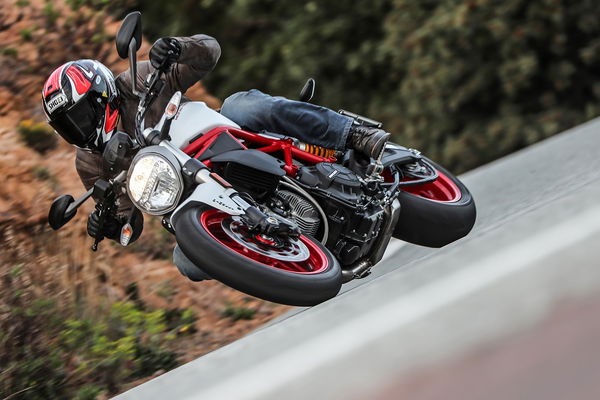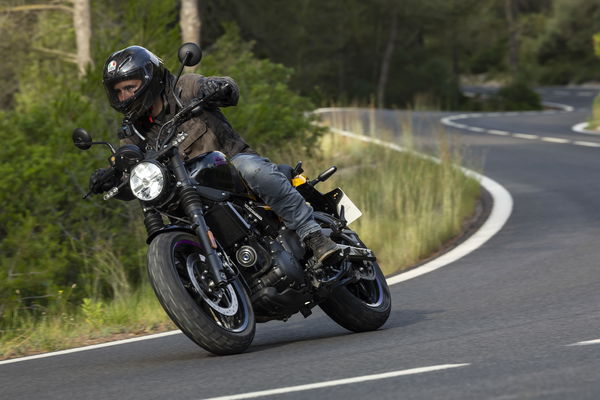Ducati Scrambler Café Racer (2017) review
The Ducati Scrambler Café Racer (2017) gives a hint of that classic 70s Ducati superbike styling in a machine that’s infinitely more rider friendly
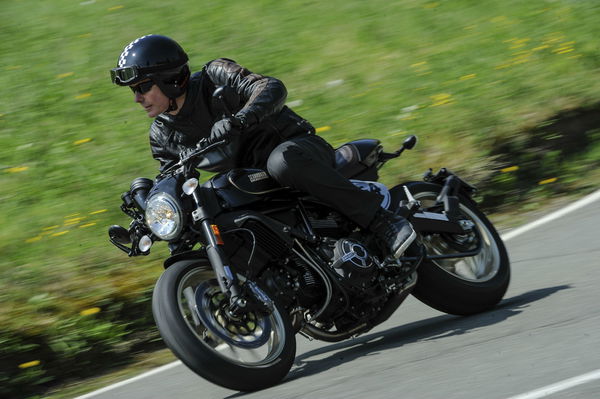
Ducati Scrambler Café Racer (2017): Design
It's no wonder the lean black-and-gold V-twin is carving up the SS65 with the pace and composure of a bike that has been this way many times before. This ribbon of tarmac south of Bologna leads over the Apennine Mountains to Mugello by way of the famed Futa Pass.
Ducati’s test riders have been developing bikes on the Futa road for decades, right back to the late-70s, when the firm’s black-and-gold 900 Super Sport was among the fastest and best superbikes on the planet. Now I’m back here for the launch of a Bologna-built bike inspired by that bevel-drive V-twin.
Rather curiously, the name most prominent on its petrol tank is Scrambler, not Ducati. That’s because despite its deliberate resemblance to one of the great Ducati models, the Café Racer is being introduced as a member of the Scrambler sub-brand of entry-level V-twins. Along with the recently launched, off-road styled Desert Sled, it’s intended to broaden the Scrambler family.
The tank badge might say Scrambler but the Café Racer’s look is all Ducati. The high, wide one-piece handlebar that characterises the original Scrambler models is replaced by a pair of clip-ons, fitted with bar-end mirrors to accentuate the nose-down image. The headlamp is also shifted downwards, and surrounded by a black-finished nacelle.
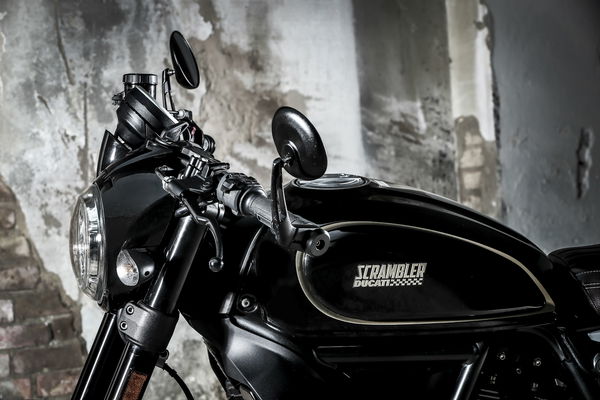
The engine is essentially the same 803cc air-cooled V-twin fitted to the other Scrambler models, complete with unchanged power delivery to a maximum of 75hp at 8,250rpm. But the SOHC, two-valve Desmo unit is also finished in black, and breathes out through a new exhaust system that ends with twin Termignoni cans on the right side.
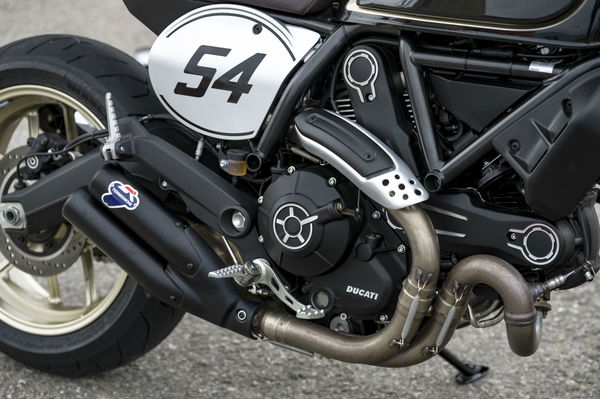
Chassis layout follows the Scrambler format of tubular steel frame with diagonally mounted single shock on the right, working a curved, twin-sided swing-arm. But a longer shock raises the rear end and steepens steering geometry, reducing rake and trail to a racy 21.8° and 93.9mm (from 24° and 111.9mm).
Other chassis parts follow the sportier theme: slightly stiffer suspension at both ends, and cast 17-inch wheels wearing Pirelli’s Diablo Rosso II street rubber. But the Café Racer retains a generous 150mm of wheel travel at each end, and its only option for adjustment comes from the shock’s pre-load collar.
There’s neat stuff elsewhere, from the minimalist front mudguard to the humped, café racer style seat with its colour-matched pillion seat cover. The race-style oval side panel carries the number 54 in tribute to former works rider Bruno Spaggiari, winner of many races but arguably best known for being narrowly beaten by his team-mate Paul Smart in the famous Imola 200 in 1972.

Despite the lean black Café Racer’s clip-on bars and race plates, it doesn’t feel much like an uncompromising street racer when you throw a leg over the ribbed seat. Those clip-ons aren’t radically low, but rise up above the top yoke, with its neat Scrambler logo, to a height that puts them within reach without need for a racy crouch.
By Scrambler standards the riding position is still sporty. The clip-ons are 175mm lower and 155mm further forward than the Icon’s wide one-piece bar; the seat is 15mm taller at 805mm; and footrests unchanged. But Ducati haven’t repeated the mistake they made a decade ago with the Sport Classic 1000, whose racy riding position proved too uncomfortable for the mostly older riders who appreciated its retro style.
Ducati Scrambler Café Racer (2017): Engine
The Café Racer manages to look reasonably aggressive, but seemed more poodle than pit-bull even before the motor fired up with an appealing but restrained, Euro4-legal beat from the low-slung exhaust. Then it was out with the light-action clutch and into the Bologna traffic, where the bike’s low weight, generous steering lock and sweet low-rev fuelling made it infinitely more rider-friendly than many of the fire-breathing Ducatis that have headed for the Futa over the years.
Suddenly that Scrambler tank badge made a lot more sense. In fact the engine response has been softened slightly from previous Scrambler lumps; following complaints of a sharp throttle, the twist-grip has been revised to give a slightly slower initial action. It worked, in that the Café Racer accelerated from low revs with no hint of abruptness.
Perhaps the flip-side was that once we got out of the city onto faster roads I needed a slightly bigger handful to let the Ducati stretch its legs, but I can’t say that was an issue. Its acceleration is hardly dramatic by Bolognese V-twin standards. But that softly-tuned Scrambler motor is pleasantly flexible and smooth, and the Café Racer revved enthusiastically through the six-speed box, heading for a top speed of around 125mph.
Not that it was particularly easy to see what the revs were doing, on the tacho bar that runs around the bottom of the single, round dial. In Scrambler tradition, instrumentation is pretty basic: digital speedo and a bunch of warning lights, but no gear indicator or fuel consumption reading.

Ducati Scrambler Café Racer (2017): Suspension and Handling
That sporty but not-too-radical riding position worked well at speed, the wind taking just enough weight off my wrists to make me think the Café Racer would be fine for a longish main-road ride. But there was no time for that, because soon we were onto the SS65, which got increasingly twisty as it headed up into the Apennines.
Those Ducati test riders have done a good job with the Café Racer’s chassis, which worked well despite its basic specification. The fact that the bike weighs just 188kg wet undoubtedly helped. It could be flicked into turns with minimal pressure on its bars, and tracked round feeling impressively neutral and controllable.
It slowed respectably hard, too. A single front disc might seem slightly stingy for a sporty bike, but the big 330mm rotor has the benefit of being chomped by a blend of Brembo’s radial master cylinder and M4.32 Monobloc caliper, giving excellent lever feel and enough pure stopping power for the fairly soft front end to cope with.
Inevitably the Café Racer’s long-travel suspension meant it cornered more like a Scrambler than a Ducati sports bike, soaking up minor bumps efficiently but feeling slightly vague and remote when the pace got hotter. At least there was plenty of ground clearance, provided I occasionally repositioned my size 11s on the pegs to avoid boot-toes touching down.
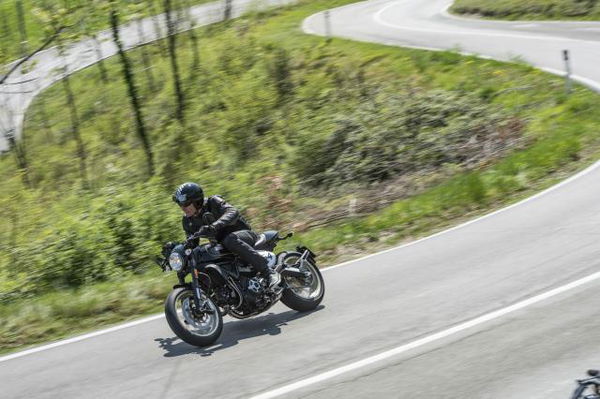
And payback for the lack of traditional Ducati-style firmness came after we’d stopped for lunch then headed back down to Bologna, when I realised that I’d been riding for several hours and was suffering only minor discomfort through the fairly thinly padded seat, and none at all from my wrists. This Café Racer is good for more than a sprint to be first in the queue for a skinny late.
Should I buy the Ducati Scrambler Café Racer (2017)?
With a reasonably generous 13.5-litre tank and fuel consumption of close to 50mpg it should have decent range, too, as well as being respectably economical to run. Shame, on that score, that the price is £9,395 – making the Café Racer £1,745 more expensive than the base-model Icon, and arguably not really an entry-level model at all despite that Scrambler name.
Fans of Bolognese V-twins who aren’t hipsters or classic enthusiasts might consider that an extra £200 would buy the much more sophisticated Monster 821, complete with 50 per cent more power and the Ducati name on its tank. But if you want the nostalgic street-racer look, this latest in the Scrambler family provides an enjoyable, unthreatening dose of café-racer style and performance without the traditional pain.

Ducati Scrambler Café Racer (2017): Specifications
- Model tested: 2017 Ducati Scrambler Café Racer
- Price: £9,395
- Engine: 803ccc V-twin
- Power: 73hp @8,250rpm
- Torque: 49lbft @5,750rpm
- Wet weight: 188kg
- Tank capacity: 13.5 litres
- Seat height: 805mm
- Available: now
